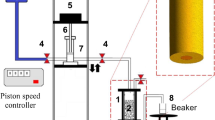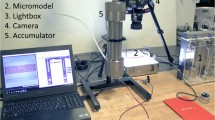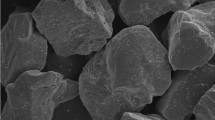Abstract
Oil displacement by an immiscible phase in porous media occurs in many important applications, including oil recovery, groundwater remediation and \(\hbox {CO}_2\) sequestration. Usually the injected fluid has a much lower viscosity than the resident oil phase and the displacement flow in inherently unstable, with the formation of viscous fingers. Polymer can be added to the injected water phase to increase its viscosity, improve the stability of the displacement front and, consequently, the efficiency of the process. Recent experimental evidences have shown that the injection of viscoelastic polymer solution can improve not only the macroscopic efficiency of the flow, but also reduce the volume of oil that remains trapped by capillary forces in a region of a porous medium that has been swept by the water phase. Despite the recent progress, the pore-scale flow mechanisms by which viscoelastic forces mobilize trapped oil ganglia are still not clear and a matter of debate. This work studies the effect of viscoelastic forces on displacement flow in porous media by comparing the residual oil saturation and trapped ganglia size distribution of three different water phases: pure water, a more viscous Newtonian glycerol solution and a viscoelastic polymer solution with the same shear viscosity of the glycerol solution. The porous medium was a transparent micromodel that consisted of a regular network of constricted capillaries. The results show that at low flow rates (low capillary and Weissenberg number), the flow behavior of the glycerol and polymer solution is very similar. At high capillary/Weissenberg number, the extra pressure associated with the viscoelastic extensional dominated flow through the constricted capillaries mobilizes trapped ganglia, leading to a lower residual oil saturation and smaller oil ganglia after the injection of the polymer solution.














Similar content being viewed by others
References
Homsy GM (1987) Viscous fingering in porous media. Ann Rev Fluid Mech 19:271–311
Lenormand R, Touboul E, Zarcone C (1983) Numerical models and experiments on immiscible displacements in porous media. J Fluid Mech 135:337
Iglauer S, Ferno MA, Shearing P, Blunt MJ (2012) Comparison of residual oil cluster size distribution, morphology and saturation in oi-wet and water-wet sandstone. J Colloid Interface Sci 375:187–192
Pye DJ (1964) Improved secondary recovery by control of water mobility. J Pet Technol 16(8):911–916
Sandiford BB (1964) Laboratory and field studies of water floods using polymer solutions to increase oil recoveries. J Pet Technol 16(8):917–922
Szabo MT (1975) Laboratory investigations of factors influencing polymer flood performance. SPE J 15(4):338–346
Dominguez JG, Willhite GP (1977) Retention and flow characteristics of polymer solutions in porous media. SPE J 17(2):111–121
Du Y, Guan L (2004) Field-scale polymer flooding: lessons learnt and experiences gained during past 40 years. In: SPE international petroleum conference Mexico, p 91787
Kim DH, Lee S, Ahn CH, Huh C, Pope G (2010) Development of a viscoelastic property database for EOR polymers. In: SPE improved oil recovery symposium Tulsa USA, p 129971
Wang D, Cheng J, Wu J, Wang G (2002) Experiences learned after production more than 300 million barrels of oil by polymer flooding in daqing oil field. In: SPE annual technical conference and exhibition San Antonio USA, p 77693
Zhang Z, Li J, Zhou J (2011) Microscopic roles of “viscoelasticity’’ in HPMA polymer flooding for EOR. Transp Porous Med 86:199–214
Wang D, Cheng J, Wu J, Wang G (2000) Viscous-elastic polymer can increase microscale displacement efficiency in cores. In: SPE annual technical conference and exhibition Dallas USA, p 63227
Afsharpoor A, Balhoff MT, Bonnecaze R, Huh C (2012) CFD modeling of the effect of polymer elasticity on residual oil saturation at the pore-scale. J Petrol Sci Eng 94:79–88
Avendano J, Pannacci N, Hezhaft B, Gateau P, Coussot P (2013) Enhanced displacement of a liquid pushed by a viscoelastic fluid. J Colloid Interface Sci 410:172–180
Wei B, Romero-Zeron L, Rodrigue D (2014) Oil displacement mechanisms of viscoelastic polymers in enhanced oil recovery (EOR): a review. J Petrol Explor Prod Technol 4:113–121
Huh C, Pope GA (2008) Residual oil saturation from polymer floods: laboratory measurements and theoretical interpretation. In: SPE/DOE symposium on improved oil recovery Oklahoma USA, p 113417
Urbissinova TS, Trivedi J, Kuru E (2010) Effect of elasticity during viscoelastic polymer flooding: a possible mechanism of increasing the sweep efficiency. J Can Pet Technol 49:49–56
Koh H, Lee VB, Pope GA (2016) Experimental investigation of the effect of polymers on residual oil saturation. In: SPE improved oil recovery conference Tulsa USA, p 179683
Qi P, Ehrenfried DH, Koh H, Balhoff MT (2017) Reduction of residual oil saturation in sandstone cores by use of viscoelastic polymers. SPE J 22(2):447–458
Berejnov V, Djilali N, Sinton D (2008) Lab-on-chip methodologies for the study of transport in porous media: energy applications. Lab Chip 8:689–693
Gunda NSK, Bera B, Karadimitriou NK, Mitra SK, Hassanizaheh SM (2011) Reservoir-on-a-chip (ROC): a new paradigm in reservoir engineering. Lab Chip 11:3785–3792
Nilsson MA, Kulkarni R, Gerberich L, Hammond R, Singh R, Baumhoff E, Rothstein JP (2013) Effect of fluid rheology on enhanced oil recovery in a microfluidic sandstone device. J Nonnewton Fluid Mech 202:112–119
de Castro AR, Oostrom M, Shokri N (2016) Effects of shear-thinning fluids on residual oil formation in microfluidic pore networks. J Colloid Interface Sci 472:34–43
Clarke A, Howe AM, Mitchell J, Staniland J, Hawkes L, Leeper K (2015) Mechanism of anomalously increased oil displacement with aqueous viscoelastic polymer solutions. Soft Matter 11:3536–3541
Groisman A, Steinberg V (2000) Elastic turbulence in a polymer solution flow. Nature 405:53–55
De S, Krishnan P, der Schaaf JV, Kuipers JAM, Peters EAJF, Padding JT (2018) Viscoelastic effects on residual oil distribution in flows through pillared microchannels. J Colloid Interface Sci 510:262–271
Ekanem EM, Berg S, De S, Fadili A, Bultreys T, Rücker M, Southwick J, Crawshaw J, Luckham PF (2020) Signature of elastic turbulence of viscoelastic fluid flow in a single pore throat. Phys Rev E 101(4):42605
Gutiérrez JAF, Moura MJB, Carvalho MS (2020) Dynamics of viscoelastic flow through axisymmetric constricted microcapillary at high elasticity number. J Nonnewton Fluid Mech 286:104438
Browne CA, Shih A, Datta SS (2020) Pore-scale flow characterization of polymer solutions in microfluidic porous media. Small 16(9):1–18
Xu K, Liang T, Zhu P, Qi P, Lu J, Huh C, Balhoff M (2017) A 2.5-d glass micromodel for investigation of multi-phase flow in porous media. Lab Chip 17:640–646
Yun W, Ross CM, Roman S, Kovscek AR (2017) Creation of a dual-porosity and dual-depth micromodel for the study of multiphase flow in complex porous media. Lab Chip 17:1462–1474
Entov VM, Hinch EJ (1997) Effect of a spectrum of relaxation times on the capillary thinning of a filament of elastic liquid. J Nonnewton Fluid Mech 72(1):31–53
McKinley GH, Tripathi A (2000) How to extract the newtonian viscosity from capillary breakup measurements in a filament rheometer. J Rheol 44(3):653–670
Oliveira MSN, Yeh R, McKinley GH (2006) Iterated stretching, extensional rheology and formation of beads-on-a-string structures in polymer solutions. J Nonnewton Fluid Mech 137(2–3):137–148
Becerra M, Carvalho MS (2011) Stability of viscoelastic liquid curtain. Chem Eng Process 50:445–449
Karim AM, Suszynski WJ, Griffith WB, Pujari S, Francis LF, Carvalho MS (2018) Effect of viscoelasticity on stability of liquid curtain. J Nonnewton Fluid Mech 257(1):83–94
Avendano J, Lima N, Quevedo A, Carvalho MS (2019) Effect of surface wettability on immiscible displacement in a microfluidic porous media. Energies 12:664
Oughanem R, Youssef S, Bauer D, Peysson Y, Maire E, Vizika O (2015) A multi-scale investigation of pore structure impact on the mobilization of trapped oil by surfactant injection. Transp Porous Media 109:673–692
Acknowledgements
The authors would like to acknowledge the financial support from the Brazilian Research Council (CNPq), Coordination for the Improvement of Higher Education Personnel (CAPES) and Equinor Brasil.
Author information
Authors and Affiliations
Corresponding author
Additional information
Technical Editor: Roney Leon Thompson.
Publisher's Note
Springer Nature remains neutral with regard to jurisdictional claims in published maps and institutional affiliations.
Rights and permissions
About this article
Cite this article
Lima, N.M., Avendaño, J. & Carvalho, M.S. Effect of viscoelasticity on oil displacement in a microfluidic porous medium. J Braz. Soc. Mech. Sci. Eng. 44, 144 (2022). https://doi.org/10.1007/s40430-022-03435-9
Received:
Accepted:
Published:
DOI: https://doi.org/10.1007/s40430-022-03435-9




